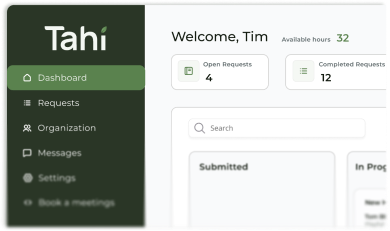Client Onboarding
Client onboarding is the crucial initial process of welcoming new clients, setting expectations, and establishing a clear foundation for a successful partnership.
What happens during a typical client onboarding process?
Client onboarding is the first official step in a new partnership after an agreement is made. It's the structured process of integrating a new client into an agency's systems and workflows. Think of it as a formal welcome and orientation session designed to ensure everyone starts on the same page, fully equipped and aligned for the journey ahead.
The process typically involves a few key stages. It starts with a kickoff meeting or call to align on goals and confirm the project scope. This is followed by information gathering where the agency collects necessary assets like brand guidelines, logins, and content. Finally, it includes setting the client up on all the required tools, such as a project management dashboard and communication channels, ensuring they know exactly how to submit requests and track progress.
Why is a smooth onboarding so important for a Webflow project?
For a Webflow project, a smooth onboarding is not just a nice to have. It is absolutely essential. Webflow projects often involve intricate design decisions in Figma and complex development structures. A strong onboarding process ensures that from day one, there is total clarity on brand application, design preferences, and technical requirements. It prevents misunderstandings that could lead to significant rework later.
It's the perfect time to establish how feedback will be shared and how design revisions will be handled before development begins through clear communication processes. This alignment prevents scope creep and ensures the transition from a Figma design to a live Webflow site through our proven handoff process is as seamless as possible. Getting this right at the start builds trust and momentum, setting a positive tone for the entire project.
How does client onboarding differ between a freelancer and an agency?
Onboarding with a freelancer is often a more informal affair. It might consist of a few emails and a quick call to get started. While this can be fast, it sometimes lacks the structure to handle complex, ongoing needs. Key information or processes might not be formally documented, which can create confusion down the line as the project evolves.
An agency, particularly one with a productised service model, typically has a more robust and systemised onboarding process. This often involves a dedicated client dashboard for all communication, file sharing, and project tracking through a single source of truth. An agency process is built for clarity, scalability, and transparency, ensuring that no matter who on the team is working on your project, the information and workflow remain consistent and clear.
What tools are commonly used for effective client onboarding?
To make onboarding seamless, agencies rely on a curated set of tools. A centralised project management platform is the most important one. This is where clients can view tasks, see timelines, and submit new requests through a structured task queue system. Tools like Asana, ClickUp, or a specialised client portal are popular choices.
Secure file-sharing solutions like Google Drive or Dropbox are used for exchanging brand assets and deliverables. For communication, while email is standard, many agencies use dedicated Slack channels for quicker, more informal conversations. The goal is to create a single source of truth. A digital hub where the client can find everything they need without having to search through endless email threads.
How can a great onboarding process set your business up for long term growth?
A truly great onboarding experience does more than just kick off a project. It builds the foundation for a lasting partnership. When a client feels heard, understood, and confident in the process from the very beginning, a deep sense of trust is established. This trust is the bedrock upon which genuine collaboration is built, turning the agency from a simple vendor into an extension of their own team.
At Tahi Studio, we have designed our onboarding to be exactly that. A launchpad for your long term success. Whether it is a quick start through our client dashboard or a detailed kickoff call, our focus is on creating total clarity and alignment. This allows us to move forward together with confidence through our subscription model, ensuring your digital presence not only gets built right but also continues to evolve and support your business goals for years to come.







